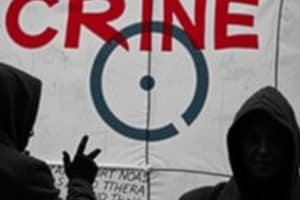Podcast
Questions and Answers
Which of the following is classified as a public order crime?
Which of the following is classified as a public order crime?
- Prostitution (correct)
- Burglary
- Assault
- Robbery
Victims of public order crimes are often unwilling participants.
Victims of public order crimes are often unwilling participants.
False (B)
What are two common concepts of crime used by criminologists?
What are two common concepts of crime used by criminologists?
Social harm and morality
The belief that it is society's duty to save individuals from themselves relates to __________ regarding public order crimes.
The belief that it is society's duty to save individuals from themselves relates to __________ regarding public order crimes.
Match the following concepts to their descriptions:
Match the following concepts to their descriptions:
What is one reason why society may need to reevaluate the criminal status of an act?
What is one reason why society may need to reevaluate the criminal status of an act?
Which of the following statements most accurately reflects the role of criminologists in understanding crime?
Which of the following statements most accurately reflects the role of criminologists in understanding crime?
Crime theory only applies to violent crimes.
Crime theory only applies to violent crimes.
Name a factor that can be measured to test crime theory at the community level.
Name a factor that can be measured to test crime theory at the community level.
The legalization or decriminalization of ___________ can impact rates of certain crimes.
The legalization or decriminalization of ___________ can impact rates of certain crimes.
Match the following concepts with their corresponding definitions:
Match the following concepts with their corresponding definitions:
How does neighborhood poverty impact crime rates?
How does neighborhood poverty impact crime rates?
What is deviance primarily concerned with?
What is deviance primarily concerned with?
All deviant acts are considered illegal.
All deviant acts are considered illegal.
What do criminologists need to understand in order to design effective crime prevention programs?
What do criminologists need to understand in order to design effective crime prevention programs?
Deviance can range from __________ crimes to joining a nudist colony.
Deviance can range from __________ crimes to joining a nudist colony.
Which of the following is a technique that criminologists might develop?
Which of the following is a technique that criminologists might develop?
Match the following research tools with their purposes:
Match the following research tools with their purposes:
Legal changes have no impact on social norms.
Legal changes have no impact on social norms.
What is a method of conflict resolution that avoids formal legal proceedings?
What is a method of conflict resolution that avoids formal legal proceedings?
Flashcards are hidden until you start studying
Study Notes
Overlapping Areas of Concern
- Understanding when deviant behaviors transition into crimes is crucial for criminology.
- Legal distinctions exist between suggestive and obscene sexually oriented materials.
- Community-level crime rates can reveal correlations between ecological factors, such as poverty and unemployment, and crime status.
- Debate continues over the legalization and decriminalization of various issues, including abortion, recreational drug use, possession of handguns, and assisted suicide.
- Public order crimes include pornography, prostitution, and drug use, despite the existence of willing participants in these acts.
- Some argue society has a responsibility to protect individuals from their own choices regarding deviant behaviors.
Criminological Perspectives
- A criminologist's orientation influences their definition of crime, leading to varying opinions within the field.
- Accurate criminal statistics and data are necessary for crime prevention and rehabilitation program design.
- Techniques for collecting and analyzing institutional records (police, court, and corrections) are essential for effective crime control.
- Surveys can be developed to measure unreported criminal activity, providing insight into crimes that victims do not disclose to law enforcement.
Understanding Deviance
- Deviance encompasses behaviors that diverge from established social norms, including both legal and illegal actions.
- Not all crimes are categorized as deviant; some may be socially accepted within certain contexts.
- Victim identification is important; surveys can help understand the extent of crime by capturing information from unreported incidents.
Studying That Suits You
Use AI to generate personalized quizzes and flashcards to suit your learning preferences.




